
Official Edgar Rice Burroughs Tribute and Weekly Webzine Site
Since 1996 ~ Over 15,000 Webpages in Archive
Volume 0053
![]()
Studley
Oldham Burroughs
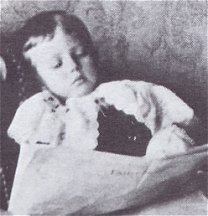
1892 - 1949
Compiled
by Bill Hillman
![]()

![]()
Studley
Oldham Burroughs

1892 - 1949
Compiled
by Bill Hillman
![]()
Studley Oldham Burroughs was ERB's nephew, born December 26, 1892 to brother Harry and his wife Ella (Nellie) Burroughs. He was named after his father whose full name was Henry Studley Burroughs, and his mother whose maiden name was Oldham. Both Studley and his sister, Mary Evelyn (born March 12, 1895) were born in Chicago. Harry and Nellie took both children to Minidoka during the Burroughs brothers gold mining venture.The Burroughs family were quite excited about the birth of the new baby boy. In April 1895 Ed wrote to his brother, "How is the kid? From all of your letters I will expect to find him riding a bicycle and reading Caesar on my return in the summer. Don't rush him too much. He may get brain fever. Just tell him to follow after his uncle - if he wants to be a blooming idiot."
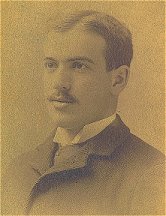
Copyright ERB, Inc. Father Harry Burroughs |
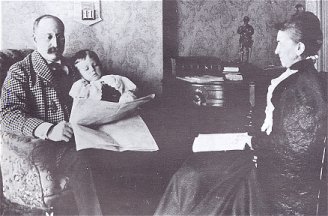
Young Studley with grandparents George Tyler and Mary Evaline Burrough ~1896 |
Young Studley, the budding artist was probably influenced by his uncle Ed more than most people realize. Long before his talents as a writer were recognized worldwide, Ed was writing humorous bits of fantasy, which he illustrated with quite clever and artistic sketches and cartoons. In 1909, ERB sent his young nephew a personally illustrated Christmas card. His verse is headed in large capitals: "S.O.B." and he jokes about his financial state: "Please accept from Edgar Rice The best he's got to give -- advice: Start a Bank Account."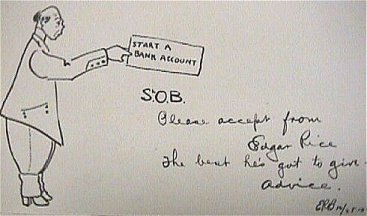
From the Danton Burroughs Family Archive ~ Copyright ERB, Inc. ~ Not for duplicationERB helped (probably unsuccessfully) to get Ella's stories and poems published. Ella's writing was far from the fantasy vein so popular with her brother-in-law. Her themes dealt with more realisitic human relationships and settings, and were no doubt influenced by the primitive lifestyle in the wilds of Idaho to which she had to adapt. The experience of raising two young children on a houseboat on the Snake River at the turn of the century was obviously in stark contrast to anything she had experienced in her younger days back in civilization. Her writing style mirrored a woman of great sensitivity -- a sensitivity and intenseness that was obviously passed on to her son.The family's artistic talent influenced Studley who was drawing and painting at an early age. He sketched constantly and even created murals on the wallpaper of their home. He reflected in later years: "From the cave man down, I assume the artist's impulse instinctively has sought to express itself in mural decoration, so I simply behaved true to type." The young cave man artist went on to a moderately successful career in commercial design and illustration. Studley was hired at age seventeen working as an apprentice doing lettering for a company in Chicago. He started out with almost no formal training but studied at nights at a wide variety of places of art instruction. One of his major influences was Audubon Tyler, one of his instructors at the National Academy of Art in Chicago.
He went on to work as a feature artist at the Chicago Herald from where he moved to New York to work for Mothers Magazine. From there he moved to Los Angeles where his uncle Ed helped him gain employment at the Foster and Keiser Company. In 1914 Ed Burroughs wrote his main contact at All-Story Magazine to enquire about job possibilities for his nephew: "By the way, if my nephew cared to submit a cover design with one of my future stories would it receive consideration? He's a mighty clever young chap, and I don't know of anyone I'd rather swee him get a start with than you. He's doing rather well now, but nothing very steady, and his work is improving wonderfully." It was around this time that his work appeared as an illlustration in his grandmother, Mary Evaline's Memoirs Of A War Bride, in which she related her experiences during the American Civil War.
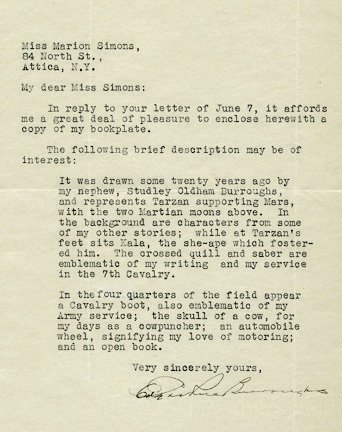
click Studley also did work for The Los Angeles Tribune's Sunday Fiction Magazine, including the cartoon, "Self-Control Is A Wonderful Virtue in the February 27, 1916 issue and an illustration for "Red, the Mediator" by Montague Glass in the March 19, 1916 issue.
Studley also did work for The Los Angeles Tribune's Sunday Fiction Magazine, including the cartoon, "Self-Control Is A Wonderful Virtue in the February 27, 1916 issue and an illustration for "Red, the Mediator" by Montague Glass in the March 19, 1916 issue.
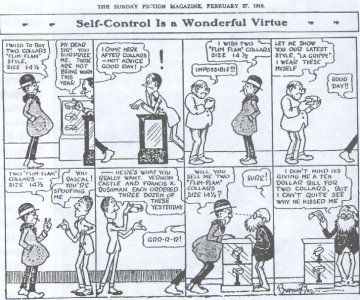 |
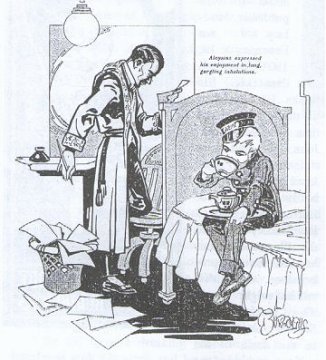 |
On April 22, 1919, his wife of only two years (Mary Becker) died in childbirth. On the verge of a breakdown, Studley, leaving his infant daughter in the care of his parents, accepted ERB's invitation to visit Tarzana Ranch. He helped lay out a nine-hole golf course and even designed a special golf scorecard.

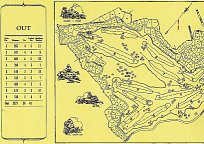
It was probably around this time that Studley designed an ex libris (bookplate) for ERB's personal books. He described the 4" x 2 1/4" design in a letter to ERB:"The central figure is Tarzan embraced by one of his apes (Kala perhaps) and upholding the Planet Mars, which can be easily identified by its two moons, the Greater and the Lesser. (Not being a landscape artist I omitted the canals. They are the only things I think I have omitted.) The pen crossed with the sword indicate what I believe to be your two chief interests at this date. The laurel wreath, of course, depicts a degree of fame. In the crest below I have symbolized the four most pronounced epics of your career, starting with your days in the Cavalry, and following, in order, your life in the West, your return to the more civilized East, and lastly, your advent in the world of books, magazines, et al. (If anything of moment occurred before this, it was prior to our acquaintance.) In the panel behind Tarzan may be found my conception of the characters in some of your other bully-good stories."ERB proudly sent copies of the ex libris to book collectors and fans, often accompanied by the above interpretation. He even added:"The shield in the lower left hand corner represents what my nephew conceived to be four important epochs of my life -- my interest in military affairs being symbolized by the cavalry boot and spur, the cow's skull representing my experience as a cowboy, the automobile wheel my interest in motoring, and the open volume my love of books."In March 1920 he rushed back to Chicago where his year-old daughter Margaret Mary had been stricken with spinal meningitis -- she died before he could reach her.
|
Concerning the grief over the serious illness of son Studley's child. From the personal archives of Danton Burroughs COVERING NOTE FROM MOTHER on Tarzana Ranch Letterhead TARZANA RANCH Edgar Rice Burroughs Van Nuys California Telephone Van Nuys 100 I am sending Harry's letters as they will give
you a better idea of conditions than anything I could write.
Letterhead: National Life Insurance Company ~ 29 South La Salle Street ~ Chicago Mar 21 1920 |
|
Following this traumatic experience Studley was hired by Chicago's Thomas Cusack Company -- a company that later became the General Outdoor Advertising Company. While here he illustrated ads for McDonald Shirts, America's Cup Coffee and Poll-Parrot Shoes.
In 1929, ERB, unhappy with the work of artist Rex Maxon in the newspaper Tarzan comic strips, corresponded with Studley to seek his opinion. Studley supplied Ed with detailed criticisms which he forwarded to the Metropolitan Syndicate as an aid to the improvement of the current cartoons.On February 19, 1931 Studley offered to illustrate his uncle Ed's books for the newly formed publishing company, ERB Inc. ERB's first choice was his favourite artist J. Allen St. John, but St. John's rates were too high for this fledgling publishing company to meet in the lean depression years. The less experienced Studley agreed to his uncle's rates: $150 for a book jacket, $175 for a wrap-around jacket, and $75 for a frontispiece.
Ed's decision to hire his nephew was somewhat of a risky decision. The trauma experienced by Studley in the death of his wife followed by the loss of his infant daughter had left him in a shattered emotional state from which he never fully recovered. A second marriage, leading to the birth of two daughters, June and Beverly, had produced even further personal problems. Added to this were his struggles to achieve a permanent success as a commercial artist. To aid his nephew financially, Ed, in 1930, had given Studley several advances on illustrations to be done in the future. Studley's emotional instability had caused him to seek support through an over dependence upon alcohol. As a result of all these problems, the possibility of Studley doing creative work on the tight schedule that Ed demanded was in question.
Studley's early sketches for the first book, finally titled Tarzan the Invincible (originally "Tarzan and the Man Things" and "Tarzan, Guard of the Jungle") received Burroughs' approval. In letters to Studley and other illustrators ERB dictated his requirements to a most meticulous degree and his explicit and detailed "suggestions" could hardly fail to be disconcerting and frightening to the artists. Studley, already worried and insecure, found himself receiving these precise, lengthy outlines and explanations detailing the action, the costume, and the weapons of the character chosen by Burroughs for illustration, plus many requests for additional research to attain authenticity. Practically nothing was left to the artist's initiative or originality.
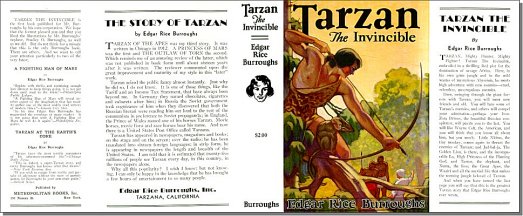
Ed had cautioned Studley that the illustrations must be finished before August 1, but with the deadline past and no material received, Ed sent an appeal to brother Harry in Chicago. The report was that Studley had taken an assignment for General Motors and Sunkist Oranges, and could find no time to complete the work. On August 10, Studley was instructed to send the incomplete drawings immediately -- only two, jacket and frontispiece, were available. Ed's plans were to have these finished by a Los Angeles artist.The drawings finally arrived, and there were hints that Studley had faced some type of a crisis; Ed had noted, "Glad to know you are out of the woods...try to forget it." Studley was urged to start work on the next book, Jungle Girl. Ed, trying to limit his requirements, did not insist that the jacket illustrate any particular story incident, and promised "plenty of latitude." He wanted a book cover that was startling, and explained, "It can be bizarre, it can be anything that willl not offend public decency, just so it attracts attention, short of being ridiculous."
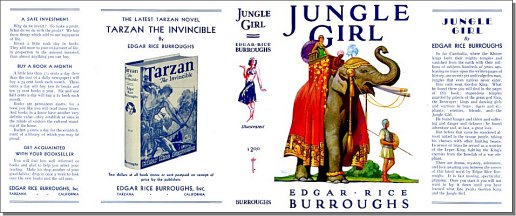
The next novel brought even more problems. Ed was experiencing financial problems brought on by the Depression, and having sent numerous cash advances to Studley without receiving either product or a response from him, was forced to write a letter to Harry on February 29, 1932. He explained that he was going to have to limit his cash outlay and that plans for future illustrations from Studley appeared uncertain. He wanted to know if Studley was serious about carrying on with the project. He had notified his nephew that the next book would be Tarzan Triumphant and that the illustrations would have to be done to his dictated requirements. He gave diplomatic praise for the artwork for Jungle Girl but it was plainly evident that he wasn't really satisfied with the product. He asked that Studley "use a little different type of feminine pulchritude from that of Jungle Girl," and wrote, "I should like to have a little more character in the face and less doll-like beauty..." He also wanted Tarzan's costume to be changed from a leopard skin to "simple loin cloth or G-string," and added, "The less Tarzan has on the more he will be in character." Realizing that the latitude he had given Studley on the previous project had not achieved satisfactory results, Ed sent a letter on March 9 containing fully detailed instructions for the dust jacket, the lettering and the four interiour illustrations:
Illustration #1: "Lion rearing and burying teeth in face of askiri -- three-quarter view from rear of lion; beyond lion and victim, the Gunner is seen coming from tent with sub-machine gun in hands." Caption: "A scream of terror burst form the lips of the doomed man." Note: If you think better to omit the Gunner as detractingattention from the principal figures, do so. However, if you show the Gunner, please show him as a black haired young man weighing about 180 pounds. He should be good looking in a sinister way. Remember that he is a tough egg and a killer; Yet a character with human appeal that I have tried to make likeable throughout the story. As this scene is transpiring at night, he need not wear a hat, but he should have on a short sleeved shirt, open at the throat, hiking breeches and field boots. This will help to differentiate him from Smith, who wears shorts. The question of the costume for the askari is one rather difficult to handle. These askaries, being the armed guards of the safaris, are often pictured in military uniform. That I do not wish in this instance. I think that you can obtain the desired result by showing this Negro in a cotton shirt falling almost to the knees and with two bandoleers of cartridges passing over his shoulders and crossing at his breast, or. . . with merely a bandoleer of cartridgres around his waist."
Illustration #2: "Tarzan lifting a shifta above his head to hurl him at other shiftas pressing close." Caption: "A white giant who fought with his bare hands." Note: "The shiftas in this and other illustrations should be costumed after the Abyssinian manner. Also, please see if you can get the Abyssinian saddle and horse trappings more or less correct. If you will refer to the June 1925 issue of National Geographic Magazine you will find all the horse trappings you need. And by referring to Page 122 of the book Savage Abyssinia by James E. Braun, you will notice illustrations of shiftas and their costumes."
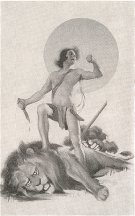 |
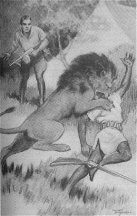 |
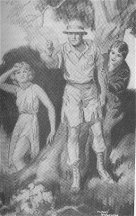 |
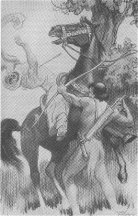 |
As the depression worsened and the book sales slumped, payments to Studley slowed and he was even asked to lower his prices for the next scheduled novel, Tarzan Triumphant. As a backup, ERB sent letters to St. John and Harold Foster, inquiring about their current rates. On March 16, 1932, Ed loyally accepted his nephew's bid of $325 over St. Johns lower price. Upon receipt of the finished jacket of Tarzan Triumphant he voiced his disappointment about "the physique of the model," writing, "He is too prissy and has a belly on him almost as large as mine... let these heroic characters of mine cave in a little below the ribs rather than stick out. Tarzan Triumphant looks as though he might be several months along toward an increase in his family...."
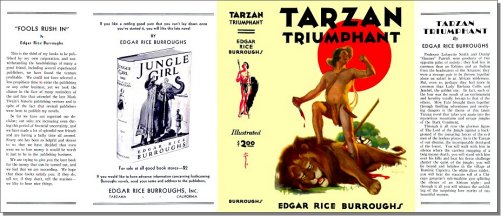
Instructions for future illustrations continued to present precise requrements. For the next novel, Apache Devil, Ed's suggestions for research and details of action and costume left little to Studley's imagination. The emotionally unstable Studley buckled under the stress and returned to drinking and he missed the completion deadlines for his assignments. The delay in receiving these illustrations forced Ed to start contacting other artists, including St. John. He offered his nephew still one more chance, however, and laid down a strict ultimatum for his work on the next novel, Tarzan and the City of Gold. Studley's preliminary sketches arrived in November 1932 and Ed sent a $100 advance. But when the January 1, 1933 deadline was missed, Ed turned the assignment over to St. John. Studley's finished sketches eventually arrive but rejected as being inferior to the work done by St. John. In a letter to St. John Ed wrote, "I am delighted with the Tarzan cover and illustrations. . . . I am sure that my readers are going to be glad to see you back again."
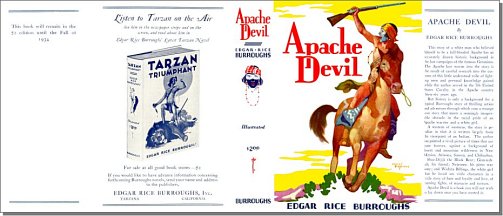
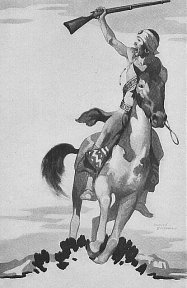 |
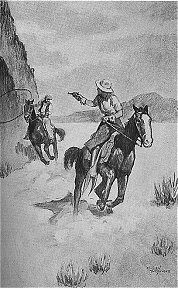 |
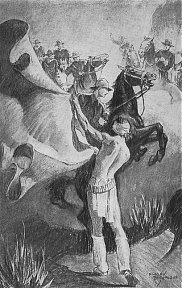 |
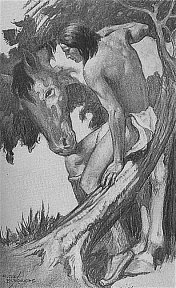 |
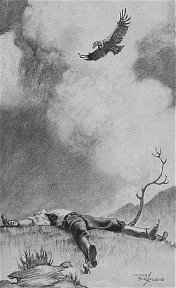 |
Sadly, this was the end of Studley's association with ERB, Inc. Although his work was not as exciting and polished as St. John's his work was generally quite appealing -- quite a feat considering the restrictions that were put on his work and personal problems he was going through at the time. In fact his work came to the attention of Frank Cash, whose advertising and public relations company produced the Mountie advertising campaign for the Northwest Paper Company. This led to another major contract for which he did quite admirable work. Samples of this work are featured in the 2003 book by Karal Ann Marlilng, Looking North: Royal Canadian Mounted Police Illustrations: Potlatch Collection.
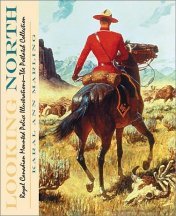
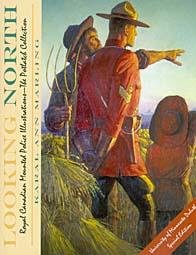
Apparently his various problems over the years did not interfere greatly with his relationshp with his family. Robert Barrett in Erbania #72/73 quoted daughter Beverly Burroughs English as having fond memories of her father:"...he was a wonderful father: kind, loving, and hilariously funny -- fun to be with. He had a seriously trained tenor-baritone voice and often sang for the enjoyment of his family. He told us stories and read to us. And he tried to teach us how to play golf, but his effort was unsuccessful. We never lacked for enthusiasm and night after night he took us to the driving range where he exercised the patience of Job! He did have a drinking problem but it never interfered with his work and he was able to conquer it. It was the timing that was bad. . . it came at a crucial period in his life and career and at the time of a deepening depression. After divorcing my mother, Alice (who passed away in August, 1989) Studley married Marie English (no relation to my husband Tom) in 1935. She, God Bless her, gave him the love and support he needed to overcome his problems."By 1936 Studley was totally recovered and never drank again. He renewed old acquaintances, did beautiful work, bought a home in Glen Eleyn, Illinois, and was a successful man in every sense of the word when I saw him for the last time. This was at my wedding in our home in August of 1948."
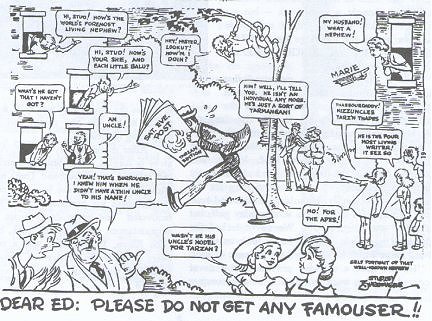
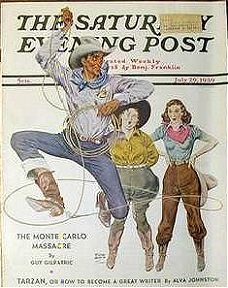 |
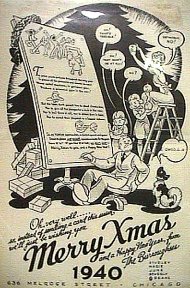 |
On December 23, 1949, Studley Burroughs died of an embolism at age 57 following an operation for hiatus hernia. His uncle Ed, suffering from serious heart problems and Parkinson's Disease, was not told the bad news. In all, Studley had illustrated four Burroughs novels: Tarzan the Invincible, Jungle Girl, Tarzan Triumphant, and Apache Devil (1931-1933).Studley's ties with his uncle remained strong. After The Saturday Evening Post did a feature article on Edgar Rice Burroughs in the July 29, 1939 issue ( ERBzine 0527 and ERBzine 0528 ), he did a very clever cartoon as a humorous tribute to the event. He also drew and sent out personalized Christmas cards to family and friends each year, such as the one pictured here from the Danton Burroughs Family Archive.
STUDLEY OLDHAM BURROUGHS TRIBUTES
Part
of our Burroughs Family Tribute Series
|
Biography and Art |
Family Christmas Memories |
The Final Years |
|
Cartoon Art |
Larger DJ Images |
Scrapbook |
![]()

![]()
BILL
HILLMAN
Visit
our thousands of other sites at:
BILL
AND SUE-ON HILLMAN ECLECTIC STUDIO
ERB
Text, ERB Images and Tarzan® are ©Edgar Rice Burroughs, Inc.-
All Rights Reserved.
All
Original Work ©1996-2010/2017 by Bill Hillman and/or Contributing
Authors/Owners
No
part of this web site may be reproduced without permission from the respective
owners.